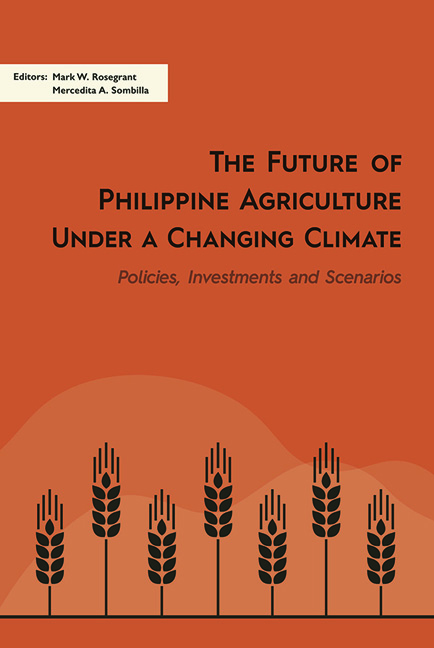Book contents
- Frontmatter
- Contents
- List of Tables
- List of Figures
- List of Appendices
- Preface
- Acknowledgements
- List of Contributors
- PART I Setting up the Scenarios: Current Status and Potential Impacts of Climate Change to Philippine Agriculture
- PART II Climate Change Adaptation Strategies and Sustainability of Philippine Agriculture
- 5 The Sustainability of Agricultural Growth
- 6 The Gendered Impacts of Climate Change
- 7 Adaptation and Mitigation Strategies
- 8 Risk Management and Coping Strategies
- PART III Investments and Supporting Policies to Alleviate Climate Change Impacts to Philippine Agriculture
- PART IV Conclusion
- Index
8 - Risk Management and Coping Strategies
from PART II - Climate Change Adaptation Strategies and Sustainability of Philippine Agriculture
Published online by Cambridge University Press: 29 May 2019
- Frontmatter
- Contents
- List of Tables
- List of Figures
- List of Appendices
- Preface
- Acknowledgements
- List of Contributors
- PART I Setting up the Scenarios: Current Status and Potential Impacts of Climate Change to Philippine Agriculture
- PART II Climate Change Adaptation Strategies and Sustainability of Philippine Agriculture
- 5 The Sustainability of Agricultural Growth
- 6 The Gendered Impacts of Climate Change
- 7 Adaptation and Mitigation Strategies
- 8 Risk Management and Coping Strategies
- PART III Investments and Supporting Policies to Alleviate Climate Change Impacts to Philippine Agriculture
- PART IV Conclusion
- Index
Summary
The Philippines is inherently vulnerable to adverse natural events of extreme intensity purely based on its geographic location.1 The warm western Pacific waters, normally around 28°C, contribute to the formation of typhoons, 18–20 of which reach the Philippines each year on average. Cagayan Valley (Region 2), Central Luzon (Region 3), and the Cordillera Administrative Region (CAR) are particularly vulnerable, averaging about seven to nine typhoons per year (Figure 8.1). Flooding occurs in a number of regions, the Western Visayas registering the highest incidence. The Philippines also rests on the Pacific “Ring of Fire”, where most of the earth's volcanic eruptions and earthquakes occur. Geophysical events, such as earthquakes and tsunamis, occur with regularity, albeit at long intervals. The Bicol Region, home of the active Mayon Volcano, experienced the greatest number of volcanic eruptions during 1991–2006. Earthquakes of moderate and high magnitude occur most frequently in the Central Visayas and Bicol regions (Figure 8.1).
Climate projections for the Philippines are similar to those in many other parts of the world (Chapters 2 and 4, this volume). Using the Intergovernmental Panel on Climate Change (IPCC) for the “A1B scenario” most relevant to the Philippines, Cinco et al. (2013) projected that mean yearly temperatures will rise between 1.9°C and 2.2°C by 2050, over baseline levels of between 25.5°C and 27.6°C (derived as averages of minimum and maximum temperatures for the 1971–2000 period). Increasing rainfall concentration and mean rainfall levels indicate that the wet seasons of June–August and September–November will become wetter in Luzon and Visayas towards 2050, yet higher rainfall concentrations combined with higher temperatures are likely to increase moisture stress in the dry season. In particular, it is expected that the frequency of damaging storms will increase. Although disputed by some (Cruz et al. 2007), evidence also suggests that the frequency of droughts will increase (Miyan 2015). One implication of these changes is that farmers’ experience of the frequency, duration, strength, and timing of rainfall and the frequency of droughts will be less reliable than previously; hence, the accuracy of their subjective decision-making processes will decline, causing their level of risk to rise. Past experience will become — and is already becoming — less useful as a predictor of future experience. The bottom line is that risk and uncertainty facing farmers are increasing.
- Type
- Chapter
- Information
- The Future of Philippine Agriculture under a Changing ClimatePolicies, Investments and Scenarios, pp. 324 - 374Publisher: ISEAS–Yusof Ishak InstitutePrint publication year: 2018

